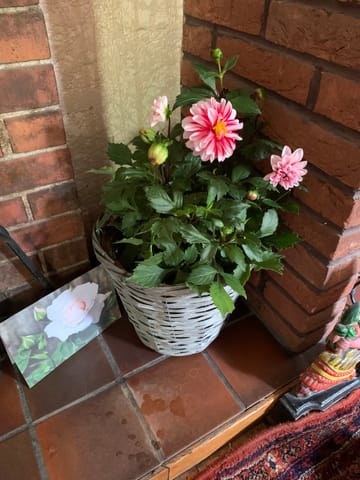Dahlia
Out of stock


- British Grown, bushy plants in a 5L Pot
- Available again for Summer 2026
- Delivered gift wrapped with a choice of stylish pots
Available again for Summer 2026, we do have lots of other lovely garden plants we can send as gifts.
 4.9/ 5
7 reviews
4.9/ 5
7 reviews



Great healthy plant!

Great company and plants

Excellent service

Beautiful product. Arrived perfect!

Superb quality,very well wrapped and quick delivery

Really pleased, arrived in one piece! Lovely thanks

Unfortunately the plant sent to our friend for her birthday was damaged.

These instructions are sent with the plant gift
Dahlia is a bushy, tuberous, herbaceous perennial plant native to Mexico and Central America. They have been a popular plant for the UK garden for many years and are known for their particularly long flowering period.
Dahlia naturally occur in warm sunny spots, but they do need to be watered regularly when it is warm. If keeping your plant in the pot do make sure to water regularly, you’re aiming to keep the soil moist. Water regularly when the top of the soil dries.
During the growing season regularly feed you dahlia with a balanced fertiliser feed. They have already been re-potted this season but if the roots are starting to grow out the bottom or the tubers are pressing against the side of the plastic you can pot up again and this will help the Dahlia tuber to expand so you can create more babies next year.
Dahlia grow from a tuber or rhizome and so will naturally die back at the end of the season. When the leaves start to turn brown from the tips, stop watering and let all the goodness from the leaves die back into the roots. Once the foliage has died off completely lift the entire root ball and you should find you have a sizeable Tuber to split into new plants net year.
If you’d like to grow your dahlia again next year, store your tubers in a paper bag with a bit of slightly damp soil so they do not dry out over winter. Keep them in a cool dark place. Replant in the spring as it starts to warm up but do try to keep the soil on the dry side until you see growth above the soil. Then continue to feed and water regularly.
Problem solving:
Brown tips to the leaves are quite common in the autumn and a sign that your plant is entering its dormant period. Summer browning and crinkling of the new leaves is a sign of either scorch or the plant is not getting enough to drink. Yellowing is the opposite so do allow longer time between waterings. Over time the lower leaves will naturally shrivel and can be removed to keep the plant looking fresh.









